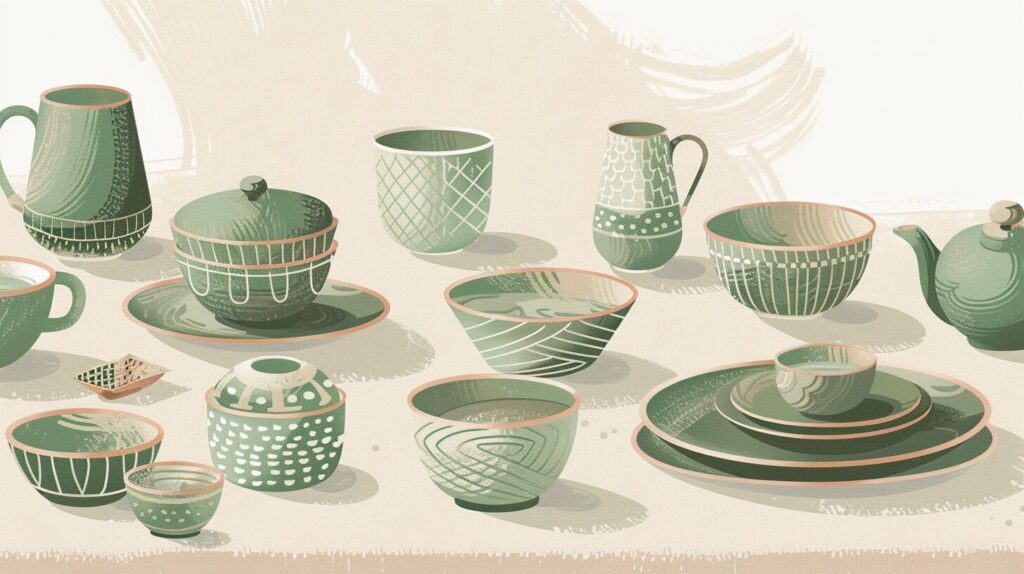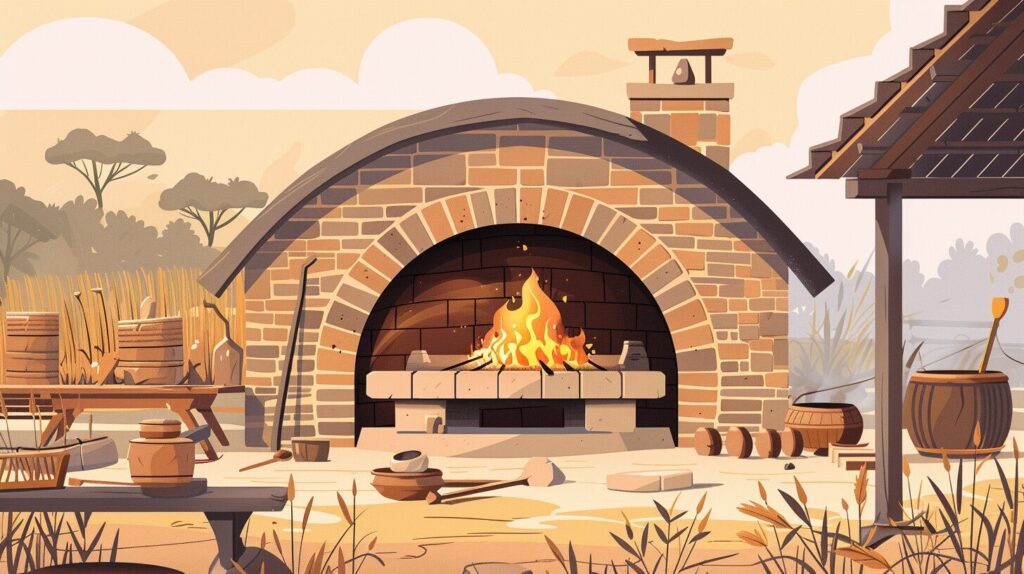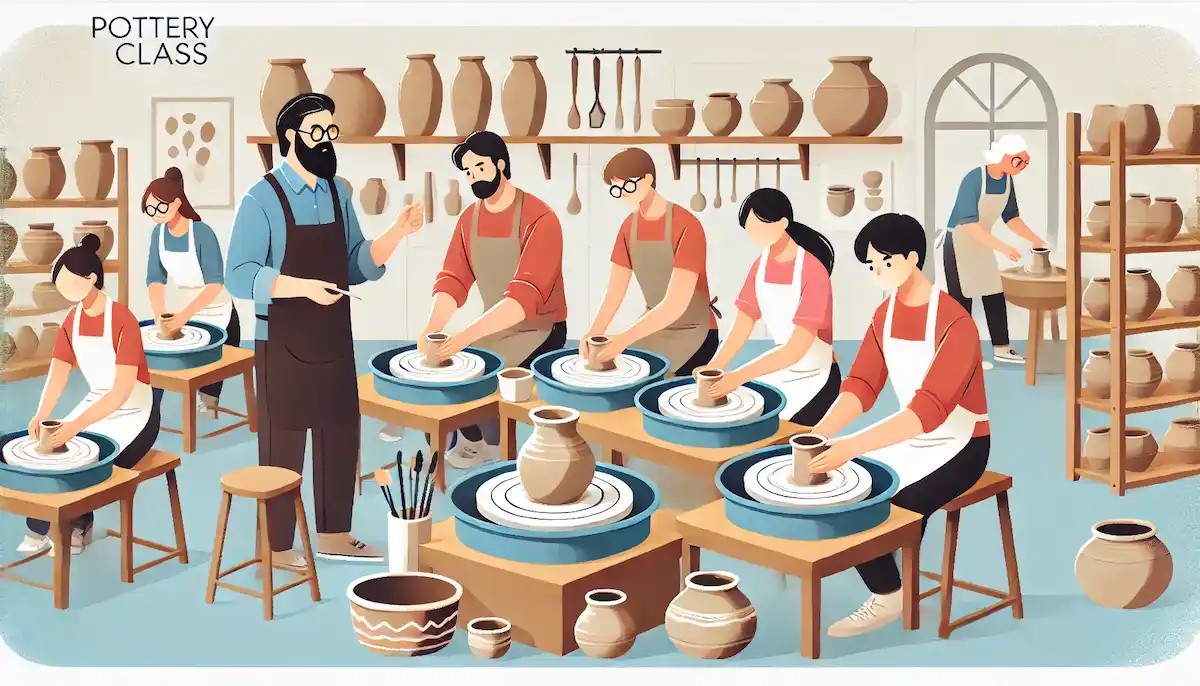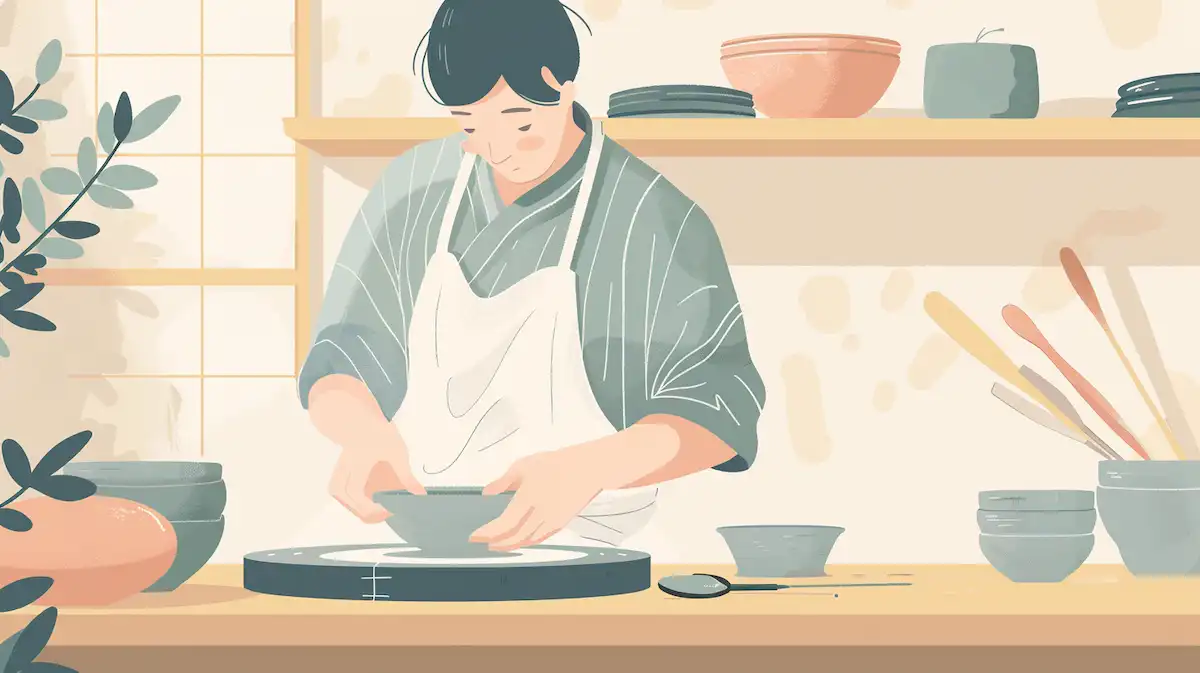瀬戸焼を英語で説明・紹介するための基本情報と、英会話に役立つ表現をシンプルでわかりやすい英語で紹介します。
英会話ダイアローグ・関連情報・10の質問を通して、瀬戸焼に関する英語表現を学びます。
英語
英会話ダイアローグを読む前に知っておくと良い前提知識と情報です。
- 瀬戸焼とは
- 愛知県瀬戸市で作られる伝統的な陶磁器
- 日本の六古窯の一つ
- 特徴
- 豊富な種類の釉薬(ゆうやく)やデザインが特徴
- 実用性と美しさを兼ね備えた食器や茶道具として日常的に使われている
- 主な瀬戸焼の種類
- 織部:緑色の釉薬が特徴
- 黄瀬戸:黄色みを帯びた温かな色調
- 魅力と人気
- 瀬戸焼は日本国内だけでなく、海外でも人気
- 実用的でありながら芸術性も高く、耐久性に優れている点が魅力
- 重要な用語
- 六古窯: 六つの古い窯のこと、瀬戸焼はその一つ
- 釉薬: 陶器の表面にかけるガラス質のコーティング
2人が瀬戸焼について話しています。
瀬戸焼の歴史や特徴、魅力、織部焼や黄瀬戸、実用性と美しさの両立、国内外での人気、陶芸体験などを話題にしています。
会話 / dialogue

Hey Key, I’ve been really interested in Seto ware lately. Have you heard much about it?

Yeah, Seto ware is pretty famous, right? It’s one of Japan’s Six Ancient Kilns. What got you into it?

Well, I came across some beautiful pottery at a local market. The vendor mentioned it was Seto ware, and I was curious. I didn’t know that it has such a long history—over 800 years!

That’s right! It started in the 13th century when a potter named Kato Kagemasa brought techniques from China to Seto. It’s interesting how Seto ware has developed such a wide range of styles, from traditional to modern.

Yeah, that variety is one thing that really caught my attention. I saw some pieces with a green glaze, and the vendor told me it was Oribe ware. I had never seen anything like it before.

Oribe ware is a classic. It uses a copper green glaze and has creative, almost asymmetrical designs. It became popular during the Azuchi-Momoyama period. Seto ware is cool because it’s not just about one style—there’s also Kizeto, which has a beautiful yellow glaze.

Exactly! I also learned that Seto ware isn’t just for decoration. It’s really practical. People use it for everyday dishes, tea utensils, and more.

True, and that’s part of its charm. It combines functionality with beauty. Seto ware is known for being durable too, so it’s perfect for daily use. But at the same time, it looks elegant.

I can see why it’s so popular, especially in Japan. But I heard it’s well-known abroad as well. Do you know much about that?

Yeah, it became popular overseas, especially after the Meiji period when they started exporting it. Seto ware is seen as a symbol of Japanese ceramics, and collectors love it for its craftsmanship.

That makes sense. It must be because of the balance between tradition and innovation. I read that Seto potters have kept their traditional techniques while adapting to modern trends.

Exactly. They’ve been able to innovate without losing the essence of what makes Seto ware special. That’s probably why Seto city is still a major pottery center today, with events like the Seto Pottery Festival drawing lots of visitors.

I’d love to visit Seto during the festival! It would be amazing to see the workshops and meet the artisans. I heard the whole town is involved in pottery making.

You should definitely go. It’s a great chance to see how deeply pottery is rooted in the local culture. Plus, you can get some unique pieces directly from the artists.

That sounds perfect. I really want to learn more about the different styles and techniques. It’s fascinating how each piece has its own character.

For sure! And if you’re interested, you could even try making your own pottery at some of the workshops. It’s a great way to understand the craft better.

I’d love that! I feel like there’s so much more to learn about Seto ware. I’ve only scratched the surface.

Well, the more you explore, the more you’ll appreciate it. Seto ware really shows how art and everyday life can come together.

Yeah, that’s what makes it so appealing. I think I’ll start collecting some pieces—it’s not just art, but something I can use every day.

Great idea! Each piece you collect will have its own story, and you’ll always be reminded of its history and craftsmanship when you use it.

Exactly. I can’t wait to dive deeper into the world of Seto ware.
概要(瀬戸焼の魅力と特徴:歴史・種類・使い方)
「瀬戸焼」について、理解を深めるための「英語での関連情報」です。
瀬戸焼

History of Seto Ware
Seto ware is a type of traditional Japanese pottery that started in the 13th century in Seto city, Aichi Prefecture. It was founded by a potter named Kato Kagemasa, who brought ceramic techniques from China to Japan. Seto ware is one of the Six Ancient Kilns of Japan, and it has a long history of over 800 years.
Variety and Styles
One special feature of Seto ware is its wide variety of styles. Unlike other types of pottery, Seto ware includes many different colors, designs, and glazes. Some famous styles are Oribe ware, with its green glaze, and Kizeto, with a beautiful yellow glaze. This variety makes Seto ware suitable for both traditional and modern uses.
Practical and Beautiful
Seto ware is known for being both practical and beautiful. People use it for everyday dishes, tea utensils, and decorations. It is also very durable, making it perfect for daily use. At the same time, its artistic design makes it a popular choice for collectors.
Popularity in Japan and Abroad
Seto ware is popular in Japan and has also become well-known abroad. Since the Meiji period, it has been exported to many countries. Its combination of tradition and innovation continues to attract people from all over the world.
10の質問(瀬戸焼を知る基本知識)
「瀬戸焼」について、理解を深めるための「英語での10の質問」です。
1: What is Seto ware?
Seto ware is a type of traditional Japanese pottery from Seto city in Aichi Prefecture. It has been made for over 800 years and is known for its variety of styles and glazes.
2: Who started Seto ware?
Seto ware was started by Kato Kagemasa in the 13th century. He brought ceramic techniques from China to Japan and developed pottery in Seto.
3: What are some famous styles of Seto ware?
Two famous styles of Seto ware are Oribe ware, which has a green glaze, and Kizeto, which has a beautiful yellow glaze. Both are popular in Japan.
4: What makes Seto ware special?
Seto ware is special because of its wide variety of styles and its combination of practicality and beauty. It is used for everyday items like dishes, but it also has artistic value.
5: How is Seto ware used?
Seto ware is used for many things, such as dishes, tea utensils, and decorations. It is durable, making it perfect for everyday use.
6: Is Seto ware popular outside Japan?
Yes, Seto ware became popular overseas, especially after the Meiji period. It has been exported to many countries and is loved for its craftsmanship.
7: What is the Seto Pottery Festival?
The Seto Pottery Festival is an annual event in Seto city where visitors can see pottery demonstrations, buy unique Seto ware, and meet local artisans.
8: Why is Seto ware considered practical?
Seto ware is considered practical because it is durable and functional. People use it in their daily lives for eating and drinking, but it also has decorative uses.
9: What materials are used to make Seto ware?
Seto ware is made from high-quality clay found in the Seto area. The clay is shaped, fired, and then covered with various glazes to create different styles.
10: How has Seto ware evolved over time?
While Seto ware maintains its traditional techniques, it has also adapted to modern trends. This balance of tradition and innovation has kept it popular for over 800 years.

和訳付
会話 / dialogue

Hey Key, I’ve been really interested in Seto ware lately. Have you heard much about it?
キー、最近瀬戸焼にすごく興味があるんだ。瀬戸焼について何か知ってる?

Yeah, Seto ware is pretty famous, right? It’s one of Japan’s Six Ancient Kilns. What got you into it?
うん、瀬戸焼は結構有名だよね?日本の六古窯のひとつだよね。どうして興味を持ったの?

Well, I came across some beautiful pottery at a local market. The vendor mentioned it was Seto ware, and I was curious. I didn’t know that it has such a long history—over 800 years!
地元の市場で美しい陶器を見かけてね。売り手がそれが瀬戸焼だって言ってたんだ。それで興味が湧いたんだけど、800年以上の長い歴史があるなんて知らなかったよ!

That’s right! It started in the 13th century when a potter named Kato Kagemasa brought techniques from China to Seto. It’s interesting how Seto ware has developed such a wide range of styles, from traditional to modern.
そうなんだよ!13世紀に加藤景正っていう陶工が中国から技術を持ち帰ったのが始まりなんだ。伝統的なものから現代的なものまで、瀬戸焼が多様なスタイルに発展してきたのは面白いよね。

Yeah, that variety is one thing that really caught my attention. I saw some pieces with a green glaze, and the vendor told me it was Oribe ware. I had never seen anything like it before.
そうなんだ、あの多様性が特に目を引いたんだ。緑色の釉薬がかかった作品を見て、売り手がそれが織部焼だって教えてくれたんだ。あんなのは初めて見たよ。

Oribe ware is a classic. It uses a copper green glaze and has creative, almost asymmetrical designs. It became popular during the Azuchi-Momoyama period. Seto ware is cool because it’s not just about one style—there’s also Kizeto, which has a beautiful yellow glaze.
織部焼は古典的なものだよ。銅の緑釉を使って、独創的でほとんど非対称的なデザインが特徴なんだ。安土桃山時代に人気が出たんだよ。瀬戸焼は、ひとつのスタイルだけじゃなくて、黄瀬戸みたいな美しい黄色い釉薬のものもあるから面白いよね。

Exactly! I also learned that Seto ware isn’t just for decoration. It’s really practical. People use it for everyday dishes, tea utensils, and more.
その通り!それに、瀬戸焼はただの飾りじゃなくて、すごく実用的なんだね。食器や茶道具として日常的に使われているんだって。

True, and that’s part of its charm. It combines functionality with beauty. Seto ware is known for being durable too, so it’s perfect for daily use. But at the same time, it looks elegant.
そうだね、それが魅力の一部だよね。機能性と美しさを兼ね備えているんだ。瀬戸焼は耐久性でも知られていて、日常使いに最適なんだけど、同時にエレガントな見た目も持っているんだよね。

I can see why it’s so popular, especially in Japan. But I heard it’s well-known abroad as well. Do you know much about that?
日本で人気がある理由がよくわかるよ。でも、海外でも評判が良いって聞いたんだけど、それについては知ってる?

Yeah, it became popular overseas, especially after the Meiji period when they started exporting it. Seto ware is seen as a symbol of Japanese ceramics, and collectors love it for its craftsmanship.
そうだよ、特に明治時代以降、輸出が始まってから海外でも人気が出たんだ。瀬戸焼は日本の陶磁器を象徴するものとして見られていて、その職人技がコレクターに愛されているんだよ。

That makes sense. It must be because of the balance between tradition and innovation. I read that Seto potters have kept their traditional techniques while adapting to modern trends.
それは納得だね。伝統と革新のバランスが取れているからなんだろうね。瀬戸の陶工たちは、伝統的な技術を守りつつ、現代のトレンドにも対応しているって読んだよ。

Exactly. They’ve been able to innovate without losing the essence of what makes Seto ware special. That’s probably why Seto city is still a major pottery center today, with events like the Seto Pottery Festival drawing lots of visitors.
その通りだよ。瀬戸焼の本質を失わずに革新を続けてきたからだと思う。それが、瀬戸市が今でも陶磁器の重要な産地であり、「瀬戸陶器祭り」みたいなイベントがたくさんの訪問者を集めている理由なんだろうね。

I’d love to visit Seto during the festival! It would be amazing to see the workshops and meet the artisans. I heard the whole town is involved in pottery making.
祭りの時に瀬戸を訪れてみたいな!工房を見たり、職人たちに会えるのは素晴らしい経験になりそうだよ。町全体が陶器作りに関わっているって聞いたんだ。

You should definitely go. It’s a great chance to see how deeply pottery is rooted in the local culture. Plus, you can get some unique pieces directly from the artists.
絶対に行くべきだよ。陶芸がどれだけ地域文化に深く根付いているかを感じられるいい機会だよ。それに、アーティストから直接ユニークな作品も手に入れられるかもね。

That sounds perfect. I really want to learn more about the different styles and techniques. It’s fascinating how each piece has its own character.
それは完璧だね。もっといろんなスタイルや技術について学びたいよ。それぞれの作品が持つ独自の個性が本当に面白いんだ。

For sure! And if you’re interested, you could even try making your own pottery at some of the workshops. It’s a great way to understand the craft better.
そうだね!もし興味があるなら、工房で自分で陶器を作ってみるのもいいかも。それで、もっと陶芸のことが理解できると思うよ。

I’d love that! I feel like there’s so much more to learn about Seto ware. I’ve only scratched the surface.
それはやってみたいな!瀬戸焼にはまだまだ学ぶことがたくさんありそうだよ。今のところはほんの表面しか知らない感じだよ。

Well, the more you explore, the more you’ll appreciate it. Seto ware really shows how art and everyday life can come together.
探求すればするほど、もっと魅力が見えてくるよ。瀬戸焼は本当に、アートと日常生活が一緒になれることを示しているんだよね。

Yeah, that’s what makes it so appealing. I think I’ll start collecting some pieces—it’s not just art, but something I can use every day.
そうだね、それが瀬戸焼の魅力だよね。いくつか集め始めようかな。アートとしてだけじゃなく、日常で使えるものだしね。

Great idea! Each piece you collect will have its own story, and you’ll always be reminded of its history and craftsmanship when you use it.
いい考えだね!集めるそれぞれの作品にはそれぞれのストーリーがあって、使うたびにその歴史や職人技を思い出すことができるよ。

Exactly. I can’t wait to dive deeper into the world of Seto ware.
その通りだね。もっと瀬戸焼の世界に深く入っていくのが楽しみだよ。
概要(瀬戸焼の魅力と特徴:歴史・種類・使い方)
瀬戸焼

History of Seto Ware
Seto ware is a type of traditional Japanese pottery that started in the 13th century in Seto city, Aichi Prefecture. It was founded by a potter named Kato Kagemasa, who brought ceramic techniques from China to Japan. Seto ware is one of the Six Ancient Kilns of Japan, and it has a long history of over 800 years.
瀬戸焼は、13世紀に愛知県瀬戸市で始まった日本の伝統的な陶磁器の一種です。加藤景正という陶工が中国から陶磁技術を持ち帰って創始しました。瀬戸焼は、日本の六古窯の一つであり、800年以上の長い歴史を持っています。
Variety and Styles
One special feature of Seto ware is its wide variety of styles. Unlike other types of pottery, Seto ware includes many different colors, designs, and glazes. Some famous styles are Oribe ware, with its green glaze, and Kizeto, with a beautiful yellow glaze. This variety makes Seto ware suitable for both traditional and modern uses.
瀬戸焼の特別な特徴の一つは、多様なスタイルです。他の陶器とは異なり、瀬戸焼にはさまざまな色、デザイン、釉薬があります。緑釉を使った織部焼や、美しい黄色の黄瀬戸が有名です。この多様性により、伝統的にも現代的にも使いやすい陶器となっています。
Practical and Beautiful
Seto ware is known for being both practical and beautiful. People use it for everyday dishes, tea utensils, and decorations. It is also very durable, making it perfect for daily use. At the same time, its artistic design makes it a popular choice for collectors.
瀬戸焼は、実用性と美しさを兼ね備えていることで知られています。日常的な食器や茶道具、装飾品として使われています。また、耐久性にも優れており、日常使いに最適です。その一方で、芸術的なデザインがコレクターにも人気です。
Popularity in Japan and Abroad
Seto ware is popular in Japan and has also become well-known abroad. Since the Meiji period, it has been exported to many countries. Its combination of tradition and innovation continues to attract people from all over the world.
瀬戸焼は日本で人気があり、海外でもよく知られるようになりました。明治時代以降、多くの国に輸出されてきました。伝統と革新を組み合わせた瀬戸焼は、今でも世界中の人々を魅了し続けています。
10の質問(瀬戸焼を知る基本知識)
1: What is Seto ware?
瀬戸焼とは何ですか?
Seto ware is a type of traditional Japanese pottery from Seto city in Aichi Prefecture. It has been made for over 800 years and is known for its variety of styles and glazes.
瀬戸焼は、愛知県瀬戸市で作られる日本の伝統的な陶磁器の一種です。800年以上の歴史を持ち、さまざまなスタイルや釉薬で知られています。
2: Who started Seto ware?
瀬戸焼を始めたのは誰ですか?
Seto ware was started by Kato Kagemasa in the 13th century. He brought ceramic techniques from China to Japan and developed pottery in Seto.
瀬戸焼は13世紀に加藤景正によって始められました。彼は中国から陶磁技術を日本に持ち帰り、瀬戸で陶器を発展させました。
3: What are some famous styles of Seto ware?
瀬戸焼の有名なスタイルにはどんなものがありますか?
Two famous styles of Seto ware are Oribe ware, which has a green glaze, and Kizeto, which has a beautiful yellow glaze. Both are popular in Japan.
瀬戸焼の有名なスタイルには、緑釉を使用した織部焼と、美しい黄色釉の黄瀬戸があります。どちらも日本で人気です。
4: What makes Seto ware special?
瀬戸焼の特別なところは何ですか?
Seto ware is special because of its wide variety of styles and its combination of practicality and beauty. It is used for everyday items like dishes, but it also has artistic value.
瀬戸焼は、多様なスタイルと実用性と美しさを兼ね備えている点で特別です。食器などの日用品として使われるだけでなく、芸術的な価値も持っています。
5: How is Seto ware used?
瀬戸焼はどのように使われていますか?
Seto ware is used for many things, such as dishes, tea utensils, and decorations. It is durable, making it perfect for everyday use.
瀬戸焼は、食器、茶道具、装飾品などに使われています。耐久性があり、日常使いに最適です。
6: Is Seto ware popular outside Japan?
瀬戸焼は日本国外でも人気ですか?
Yes, Seto ware became popular overseas, especially after the Meiji period. It has been exported to many countries and is loved for its craftsmanship.
はい、瀬戸焼は特に明治時代以降、海外でも人気が出ました。多くの国に輸出され、その職人技で愛されています。
7: What is the Seto Pottery Festival?
瀬戸陶器祭りとは何ですか?
The Seto Pottery Festival is an annual event in Seto city where visitors can see pottery demonstrations, buy unique Seto ware, and meet local artisans.
瀬戸陶器祭りは毎年瀬戸市で行われるイベントで、訪問者は陶芸の実演を見たり、ユニークな瀬戸焼を購入したり、地元の職人と会うことができます。
8: Why is Seto ware considered practical?
瀬戸焼が実用的だとされるのはなぜですか?
Seto ware is considered practical because it is durable and functional. People use it in their daily lives for eating and drinking, but it also has decorative uses.
瀬戸焼は、耐久性があり機能的であるため、実用的だとされています。日常生活で食事や飲み物に使われるほか、装飾品としても使われます。
9: What materials are used to make Seto ware?
瀬戸焼はどんな材料で作られていますか?
Seto ware is made from high-quality clay found in the Seto area. The clay is shaped, fired, and then covered with various glazes to create different styles.
瀬戸焼は、瀬戸地域で採れる高品質な粘土から作られています。この粘土は成形され、焼かれた後、さまざまな釉薬をかけて異なるスタイルを作り出します。
10: How has Seto ware evolved over time?
瀬戸焼は時代とともにどのように進化してきましたか?
While Seto ware maintains its traditional techniques, it has also adapted to modern trends. This balance of tradition and innovation has kept it popular for over 800 years.
瀬戸焼は伝統的な技術を守りつつも、現代のトレンドに適応してきました。この伝統と革新のバランスが、800年以上人気を保っている理由です。

words & phrases
英会話ダイアローグと関連情報に出てきた単語・フレーズです(例文は各3つ)。

kiln : 名詞
意味: 陶器やレンガなどを焼くための炉。An oven or furnace used for firing pottery, bricks, or other materials.
(瀬戸焼が製造される際に使用される焼成のための炉を指す)
例文:
- The pottery was fired in a kiln at high temperatures.
「陶器は高温で窯で焼かれました。」 - They built a new kiln to improve their production process.
「彼らは生産工程を改善するために新しい窯を作りました。」 - The artist carefully loaded the pieces into the kiln.
「芸術家は慎重に作品を窯に入れました。」
vendor : 名詞
意味: 商品を販売する人、特に路上や市場で売る人。A person who sells goods, especially in a street or marketplace.
(瀬戸焼を販売する市場や露店の販売者を指す)
例文:
- The vendor at the market was selling beautiful Seto ware.
「市場の売り手は美しい瀬戸焼を売っていました。」 - I bought some snacks from a street vendor.
「私は屋台の売り手からお菓子を買いました。」 - The vendor offered a discount for buying multiple items.
「その販売者は複数購入すると割引をしてくれました。」
glaze : 名詞/動詞
意味: 陶器やガラスにかけるガラス質のコーティング。A glass-like coating applied to pottery or ceramics for decoration or protection.
(瀬戸焼の釉薬を指し、緑釉や黄釉など、表面の仕上げに使われるものを示す)
例文:
- The artist applied a green glaze to the pottery before firing it.
「芸術家は焼く前に陶器に緑の釉薬を塗りました。」 - The shiny glaze gave the dish a smooth finish.
「光沢のある釉薬が皿に滑らかな仕上げを与えました。」 - They used a special glaze to achieve that deep color.
「彼らはその深い色を出すために特別な釉薬を使いました。」
durable : 形容詞
意味: 長持ちする、丈夫な。Able to withstand wear, pressure, or damage; long-lasting.
(瀬戸焼が日常使用に耐えうる耐久性があることを示す)
例文:
- Seto ware is known for being durable and perfect for everyday use.
「瀬戸焼は耐久性があり、日常使いに最適であることで知られています。」 - These shoes are made from durable materials.
「これらの靴は耐久性のある素材で作られています。」 - We need a durable table for the kitchen.
「私たちはキッチンに丈夫なテーブルが必要です。」
ceramic : 名詞/形容詞
意味: 焼き物、陶磁器。または、陶磁器の。Pottery or objects made from clay that are hardened by heat. Also, relating to ceramics.
(瀬戸焼などの陶磁器製品全般を指す)
例文:
- Seto ware is a type of ceramic made in Japan.
「瀬戸焼は日本で作られる陶磁器の一種です。」 - The museum has a large collection of ancient ceramic pieces.
「その博物館には古代の陶磁器の大規模なコレクションがあります。」 - She studied ceramic art in college.
「彼女は大学で陶磁器の芸術を学びました。」
詳細情報 / Further Info
関連記事(陶芸)

